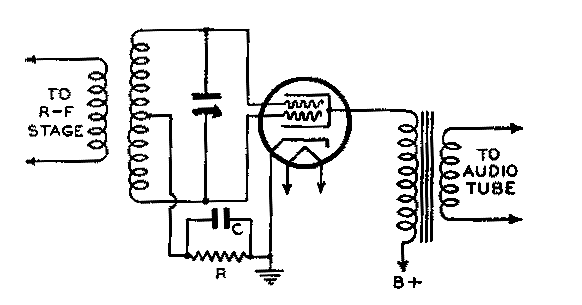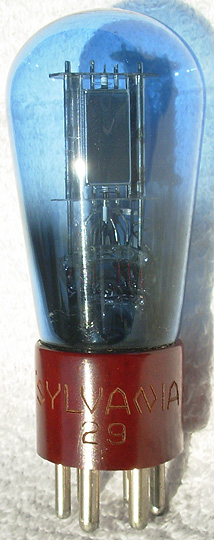Wunderlich Tubes - Who Made Them and How They Work
How it works: The Wunderlich was always used as a full wave detector. It was connected in a circuit as shown below, and it worked this way. When a signal is tuned in, one grid becomes positive, while the other grid becomes equally negative, and vice versa. Therefore, the plate current does not vary, so far as the RF signal is concerned, since both grids are always at exactly the same potential but of opposite polarity. However, each of the grids becomes positive once during each cycle. Each time that happens, the positive grid draws grid current which flows through the grid leak resistor and condenser.

In this manner, the potential of both grids decreases according to the audio variations of the modulated signal, and the plate current changes accordingly. In other words, the RF plate current changes are zero, but the audio voltage built up across the grid leak resistor and condenser is applied to both grids in parallel, since they are in the common leg, and vary the plate current at an audio rate in accordance with the modulation of the incoming RF signal. This is the distinct advantage of the Wunderlich tube - the plate current varies only at an audio rate, thus preventing RF from entering the audio system and generating what is known as fringe howl.
Identification: Arcturus was the chief maker of Wunderlich types, and "Wunderlich" was a trademark of theirs. Arcturus Wunderlich types are striking with their blue glass and dark red bases, and four variations were made. The Arcturus Wunderlich A, with a 2.5V, 1.0A filament, was made as a 5 pin tube with a grid cap and a six pin tube with no cap. The Wunderlich A-Auto is simply a 6.3V, 0.4A Wunderlich A. The rarely seen Wunderlich B (2.5V, 1.0A) and B-Auto (6.3V, 0.4A), which has an additional diode, is characterized by six pins and a grid cap. The only way of telling the difference between the Wunderlich B's is by testing.
Arcturus was the chief maker of Wunderlich types, and "Wunderlich" was a trademark of theirs. Arcturus Wunderlich types are striking with their blue glass and dark red bases, and four variations were made. The Arcturus Wunderlich A, with a 2.5V, 1.0A filament, was made as a 5 pin tube with a grid cap and a six pin tube with no cap. The Wunderlich A-Auto is simply a 6.3V, 0.4A Wunderlich A. The rarely seen Wunderlich B (2.5V, 1.0A) and B-Auto (6.3V, 0.4A), which has an additional diode, is characterized by six pins and a grid cap. The only way of telling the difference between the Wunderlich B's is by testing.
Other companies made wunderlich equivalents or near equivalents. Ken Rad sold the types 90 and 92 (also sold by KenRad as types KR20 and KR22) which are the direct equivalents of the Wunderlich A (6 pin) and Wunderlich A-Auto. Sylvania sold the types 29 and 69. The Sylvania type 29 has slightly different gain characteristics that the Wunderlich A, but has the same filament and would substitute for the Wunderlich A. The Sylvania type 69 has a 6.3V, 0.3A filament and the same characteristics as the type 29. This is similar enough to sub for the A-Auto. The Sparton type 70 is a dual grid detector with a 6.3V, 0.3A filament, but its gain characteristics are greatly different from the other automobile types, so it is not interchangeable.
Sylvania apparently purchased a few blue Arcturus-made 6 pin Wunderlich A tubes in 1935 for resale as type 29s. These are regular Wunderlich As, except "Sylvania 29" is hot-branded in the base. Regular Sylvania type 29 tubes are clear with black bases and a unique internal structure.
References:
"70 Years of Vacuum Tubes and Valves", p.83, John Stokes
"Modern Radio Servicing", p 667, Alfred Ghirardi
KenRad Tube Interchangeability Guide, 1940
Arcturus tabular data sheets dated May 1932 and September 1932
